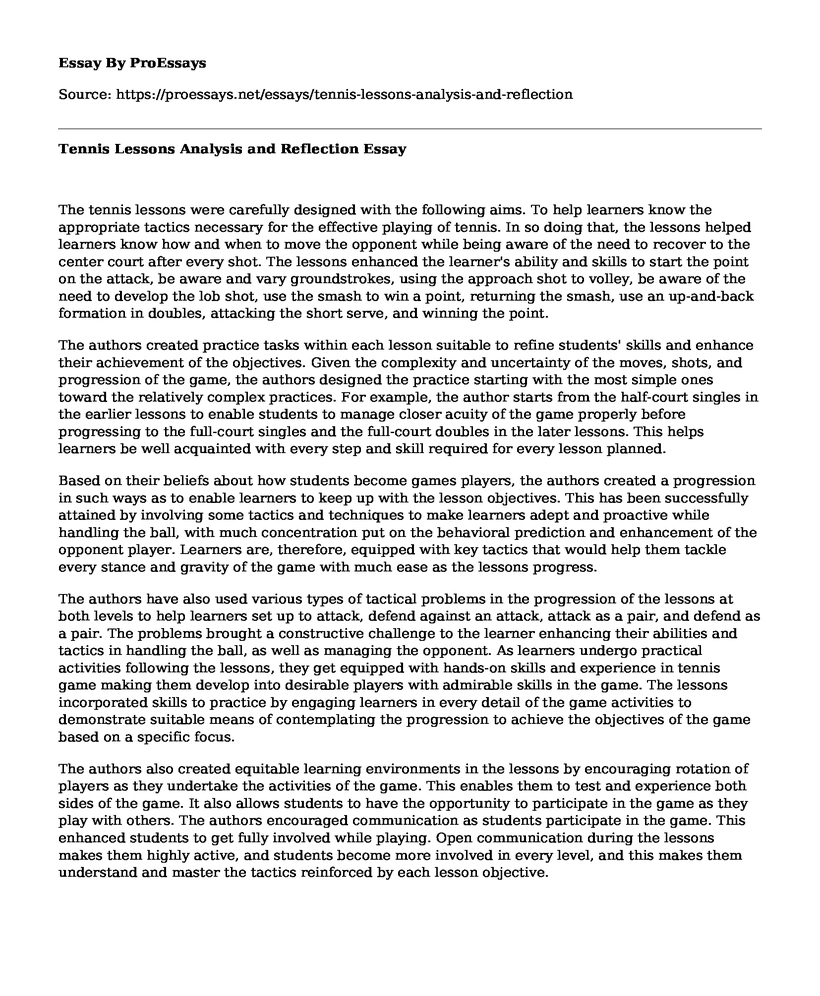The tennis lessons were carefully designed with the following aims. To help learners know the appropriate tactics necessary for the effective playing of tennis. In so doing that, the lessons helped learners know how and when to move the opponent while being aware of the need to recover to the center court after every shot. The lessons enhanced the learner's ability and skills to start the point on the attack, be aware and vary groundstrokes, using the approach shot to volley, be aware of the need to develop the lob shot, use the smash to win a point, returning the smash, use an up-and-back formation in doubles, attacking the short serve, and winning the point.
The authors created practice tasks within each lesson suitable to refine students' skills and enhance their achievement of the objectives. Given the complexity and uncertainty of the moves, shots, and progression of the game, the authors designed the practice starting with the most simple ones toward the relatively complex practices. For example, the author starts from the half-court singles in the earlier lessons to enable students to manage closer acuity of the game properly before progressing to the full-court singles and the full-court doubles in the later lessons. This helps learners be well acquainted with every step and skill required for every lesson planned.
Based on their beliefs about how students become games players, the authors created a progression in such ways as to enable learners to keep up with the lesson objectives. This has been successfully attained by involving some tactics and techniques to make learners adept and proactive while handling the ball, with much concentration put on the behavioral prediction and enhancement of the opponent player. Learners are, therefore, equipped with key tactics that would help them tackle every stance and gravity of the game with much ease as the lessons progress.
The authors have also used various types of tactical problems in the progression of the lessons at both levels to help learners set up to attack, defend against an attack, attack as a pair, and defend as a pair. The problems brought a constructive challenge to the learner enhancing their abilities and tactics in handling the ball, as well as managing the opponent. As learners undergo practical activities following the lessons, they get equipped with hands-on skills and experience in tennis game making them develop into desirable players with admirable skills in the game. The lessons incorporated skills to practice by engaging learners in every detail of the game activities to demonstrate suitable means of contemplating the progression to achieve the objectives of the game based on a specific focus.
The authors also created equitable learning environments in the lessons by encouraging rotation of players as they undertake the activities of the game. This enables them to test and experience both sides of the game. It also allows students to have the opportunity to participate in the game as they play with others. The authors encouraged communication as students participate in the game. This enhanced students to get fully involved while playing. Open communication during the lessons makes them highly active, and students become more involved in every level, and this makes them understand and master the tactics reinforced by each lesson objective.
Conclusion
There are notable differences in the elementary and secondary lessons. Elementary lessons are designed to help students learn basic concepts of playing tennis or any other game while secondary lessons are designed to empower students to build on the skills and experiences gained at the elementary lessons. Therefore, elementary lessons form the basis upon which secondary lessons thrive. As a result, students develop the resilience and patience as they undertake physical activities making them develop the required tactics and advanced techniques reinforced with creativity in action while participating in physical activity lessons.
Cite this page
Tennis Lessons Analysis and Reflection. (2022, Nov 28). Retrieved from https://proessays.net/essays/tennis-lessons-analysis-and-reflection
If you are the original author of this essay and no longer wish to have it published on the ProEssays website, please click below to request its removal:
- Workers in the Cane Essay
- Background LDP Case Study
- Stories Driving Me Crazy
- Essay Example on Standardizing Language: Achieving Uniformity in Communication
- Essay Sample on Empowering Students Through Cultural Diversity in Education
- Essay on School: A Key to Success for Every Child in the US
- Essay on Rewarding Energy Used in Athletics: Exploring College Payment & Nurturing Talent







